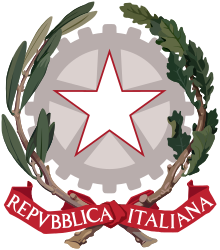Star (heraldry)
In heraldry, the term star may refer to any star-shaped charge with any number of rays, which may appear straight or wavy, and may or may not be pierced.In Scots heraldry, both star and mullet interchangeably mean a star with five straight rays;[citation needed] the official record from 1673 gives Murray of Ochtertyre azur three Starrs argent ... (Public Register, vol 1 p 188), while the Ordinary of Arms produced by a late 19th century Lyon King of Arms 'modernizes' the original as Az.[citation needed] Unlike estoiles, mullets have straight (rather than wavy) rays and may have originally represented the rowel of a spur, rather than a celestial star.An early reference of dubious historicity is reported by Johannes Letzner, who cites Conradus Fontanus (an otherwise unknown authority) to the effect that one Curtis von Meinbrechthausen, a knight of Saxony, in 1169 after committing a murder lost his rank and arms, described as an eight-pointed star beneath a chevron.Of the higher nobility in Siebmachers Wappenbuch (1605), the landgrave of Hessen and the counts of Waldeck and Erbach have stars in their coats of arms, as do several Swiss knights.It is the oldest national symbol of Italy, since it dates back to Graeco-Roman mythology[14] when Venus, associated with the West as an evening star, was adopted to identify the Italian peninsula.[14] In 1947, the Stella d'Italia was inserted at the center of the emblem of Italy, which was designed by Paolo Paschetto and which is the iconic symbol identifying the Italian State.[14] In the design of modern flags and emblems, the stars (mullets, usually five-pointed) when standing alone often represent concepts like "unity" or "independence".[citation needed] Irrespective of the statements by Paul M. G. Levy and the recent reconstruction by Susan Hood, crediting Arsène Heitz with the original design still seems to me the soundest option.



MaastrichtNetherlandsheraldrychargeblazonScottish heraldryEnglish heraldryUnited States Army Institute of HeraldryUnited Statesflag of the United StatesGreat Seal of the United StatesFrenchWayback MachineOld Frenchcelestial starModern FrenchWashington coat of armsSelby AbbeyJohannes LetznerSaxonyClan MurrayClan Douglasheraldry of the Holy Roman EmpirecadencyKaufbeurencoat of arms of ValaisSeven Tithingsparty per paleBishop of SionSiebmachers WappenbuchHessenWaldeckErbachThury-sous-ClermontValga CountyEstoniaAlfoz de QuintanadueñasDouglas familyCoat of arms of the SzékelysAmerican flagFlag ResolutionSecond Continental CongressUnited States heraldryvexillologythirteen United StatesGreat SealUnited States ArmyU.S. 16th Field Artillery RegimentThe Great Seal of the U.S.Betsy Rosseponymous flagEl Paso.Flag of ChicagoStella d'ItaliaEmblem of Italyfive-pointed starnational symbol of ItalyGraeco-Romanfive-pointed white starItalian peninsulametaphoricallyItalia turritanational personificationcogwheelallegoricalflag of ItalyItalian StateColonial Order of the Star of ItalyKingdom of ItalyItalian EmpireOrder of the Star of Italian SolidarityRepublican ItalyItalian military uniformsfigureheadItalian NavyClub Alpino ItalianoStesicoroVirgilarchaic Greek literatureStesichorusAeneasCiro MenottiExpedition of the ThousandQuarto dei MilleAndrea Doria (D 553)Star polygonSouthern Crossstar and crescentOttoman EmpireFlag of EuropeEsperanto flagUS flagflag of Brazilnational flagsUS statestimeline of the flag of the United StatesBrazilStates of BrazilTunisiaOttoman flagTurkeyRepublic of TurkeyNarciso LópezVenezuelaHondurasFederal Republic of Central AmericaNew ZealandAlbert Hastings MarkhamGeorge BowenPuerto RicoislandCuban flagFlag of Puerto RicoPhilippinesVisayasMindanaoAustraliaCommonwealth StarEpsilon Crucis1901 Federal Flag Design CompetitionAzerbaijanArabic scriptPanamaJordanfirst surahVietnam